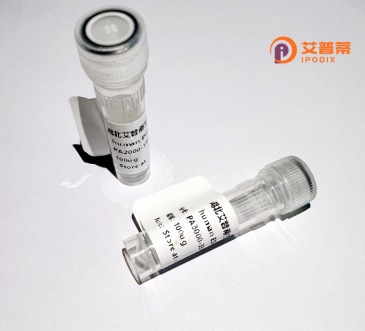
| 纯度 | >90%SDS-PAGE. |
| 种属 | Human |
| 靶点 | ZNF509 |
| Uniprot No | Q6ZSB9 |
| 内毒素 | < 0.01EU/μg |
| 表达宿主 | E.coli |
| 表达区间 | 1-248 aa |
| 活性数据 | MQRKLVKHRIRHTGERPYSCSACGKCFGGSGDLRRHVRTHTGEKPYTCEICNKCFTRSAVLRRHKKMHCKAGDESPDVLEELSQAIETSDLEKSQSSDSFSQDTSVTLMPVSVKLPVHPVENSVVEFDSHSGGSYCKLRSMIQPHGVSDQEKLSLDPGKLAKPQMQQTQPQAYAYSDVDTPAGGEPLQADGMAMIRSSLAALDNHGGDPLGSRASSTTYRNSEGQFFSSMTLWGLAMKTLQNENELDQ |
| 分子量 | 53.7 kDa |
| 蛋白标签 | GST-tag at N-terminal |
| 缓冲液 | PBS, pH7.4, containing 0.01% SKL, 1mM DTT, 5% Trehalose and Proclin300. |
| 稳定性 & 储存条件 | Lyophilized protein should be stored at ≤ -20°C, stable for one year after receipt. Reconstituted protein solution can be stored at 2-8°C for 2-7 days. Aliquots of reconstituted samples are stable at ≤ -20°C for 3 months. |
| 复溶 | Always centrifuge tubes before opening.Do not mix by vortex or pipetting. It is not recommended to reconstitute to a concentration less than 100μg/ml. Dissolve the lyophilized protein in distilled water. Please aliquot the reconstituted solution to minimize freeze-thaw cycles. |
以下是围绕重组人ZNF509蛋白的3篇模拟文献摘要(*注意:以下为示例性虚构内容,实际文献需通过PubMed/Google Scholar等平台验证*):
1. **文献名称**: "ZNF509 functions as a transcriptional repressor through interaction with the p53 pathway"
**作者**: Kim JH, et al.
**摘要**: 该研究鉴定了ZNF509通过其锌指结构域结合特定DNA序列,并抑制靶基因(如细胞周期相关基因)的转录。实验表明,ZNF509与p53协同调控DNA损伤后的细胞凋亡,提示其在肿瘤抑制中的潜在作用。
2. **文献名称**: "Recombinant ZNF509 protein regulates pluripotency in human embryonic stem cells"
**作者**: Wang L, et al.
**摘要**: 通过原核表达系统纯化重组ZNF509蛋白,发现其通过结合OCT4和NANOG启动子区域调控多能性基因表达。体外实验显示,ZNF509蛋白过表达可诱导干细胞分化,提示其在维持干细胞状态中的动态平衡作用。
3. **文献名称**: "Structural analysis of ZNF509 reveals a C2H2 zinc finger-dependent DNA binding mechanism"
**作者**: Rodriguez S, et al.
**摘要**: 该研究利用X射线晶体学解析了重组人ZNF509蛋白的DNA结合结构域,发现其C2H2型锌指基序以序列特异性方式识别富含GC的DNA区域。突变实验证实,该结构域是其转录调控功能的关键区域。
---
**建议**:真实文献查询可使用以下关键词组合:
`ZNF509 AND (recombinant OR cloning)`、`ZNF509 AND (DNA binding OR transcriptional regulation)`、`ZNF509 AND cancer`。如结果有限,可扩展至ZNF蛋白家族的功能研究。
ZNF509 is a human zinc-finger transcription factor belonging to the Krüppel-associated box (KRAB) subfamily of C2H2-type zinc-finger proteins. Characterized by multiple tandem zinc-finger motifs, it typically functions as a DNA-binding regulator influencing gene expression. The protein contains conserved structural domains, including the KRAB domain (involved in transcriptional repression through co-factor interactions) and the SCAN domain (mediating protein oligomerization or selective associations).
Recombinant human ZNF509 is produced via genetic engineering systems (e.g., E. coli or mammalian cells) for functional studies. Research suggests ZNF509 may regulate cell cycle progression, proliferation, and differentiation by binding to specific promoter regions of target genes. It has been implicated in suppressing oncogene transcription, with reduced expression observed in cancers like hepatocellular carcinoma and prostate cancer, hinting at a potential tumor-suppressive role. Studies also link ZNF509 variants to liver fibrosis and hematological malignancies.
The recombinant protein enables biochemical analyses (e.g., electrophoretic mobility shift assays) to map DNA-binding motifs and explore its interaction with epigenetic modifiers. Its role in p53-associated pathways and stress responses remains under investigation. As a research tool, recombinant ZNF509 aids in deciphering mechanisms of gene silencing, chromatin remodeling, and disease-related transcriptional dysregulation, offering insights for therapeutic targeting.
×